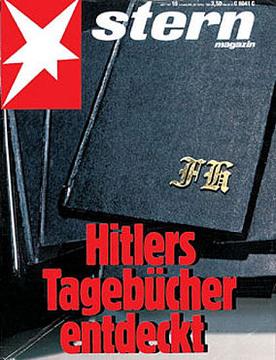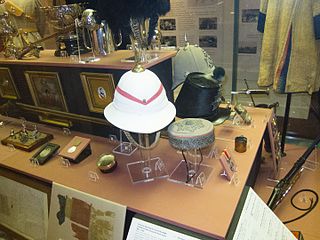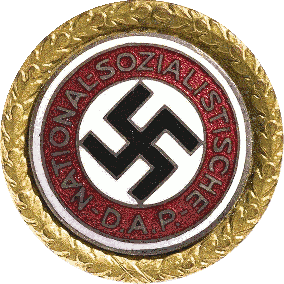
The Hitler Diaries were a series of sixty volumes of journals purportedly written by Adolf Hitler, but forged by Konrad Kujau between 1981 and 1983. The diaries were purchased in 1983 for 9.3 million Deutsche Marks by the West German news magazine Stern, which sold serialisation rights to several news organisations. One of the publications involved was The Sunday Times, who asked their independent director, the historian Hugh Trevor-Roper, to authenticate the diaries; he did so, pronouncing them genuine. At the press conference to announce the publication, Trevor-Roper announced that on reflection he had changed his mind, and other historians also raised questions concerning their validity. Rigorous forensic analysis, which had not been performed previously, quickly confirmed that the diaries were fakes.

The Gleiwitz incident was a false flag attack on the radio station Sender Gleiwitz in Gleiwitz staged by Nazi Germany on the night of 31 August 1939. Along with some two dozen similar incidents, the attack was manufactured by Germany as a casus belli to justify the invasion of Poland. Prior to the invasion, Adolf Hitler gave a radio address condemning the acts and announcing German plans to attack Poland, which began the next morning. Despite the German government using the attack as a justification to go to war with Poland, the Gleiwitz assailants were not Polish but were German SS officers wearing Polish uniforms.
Nazi songs are songs and marches created by the Nazi Party. In modern Germany, the public singing or performing of songs exclusively associated with the Nazi Party is now illegal.

Militaria, also known as military memorabilia, are military equipment which are collected for their historical significance. Such items include firearms, swords, sabres, knives, bayonets, helmets and other equipment such as uniforms, military orders and decorations and insignia.
Fascist symbolism is the use of certain images and symbols which are designed to represent aspects of fascism. These include national symbols of historical importance, goals, and political policies. The best-known are the fasces, which was the original symbol of fascism, and the swastika of Nazism.

The Golden Party Badge was an award authorised by Adolf Hitler in a decree in October 1933. It was a special award given to all Nazi Party members who had, as of 9 November 1933, registered numbers from 1 to 100,000 and had unbroken Party membership. The recipient's party number was inscribed on the reverse of the badge. Only 20,487 men and 1,795 women were awarded the badge on these terms.

The 20th-century German Nazi Party made extensive use of graphic symbols, especially the swastika, notably in the form of the swastika flag, which became the co-national flag of Nazi Germany in 1933, and the sole national flag in 1935. A very similar flag had represented the Party beginning in 1920.

The Nazi regime in Germany actively promoted and censored forms of art between 1933 and 1945. Upon becoming dictator in 1933, Adolf Hitler gave his personal artistic preference the force of law to a degree rarely known before. In the case of Germany, the model was to be classical Greek and Roman art, seen by Hitler as an art whose exterior form embodied an inner racial ideal. It was, furthermore, to be comprehensible to the average man. This art was to be both heroic and romantic. The Nazis viewed the culture of the Weimar period with disgust. Their response stemmed partly from conservative aesthetics and partly from their determination to use culture as propaganda.

Nazi chic is the use of style, imagery, and paraphernalia in clothing and popular culture related to Nazi-era Germany, especially when used for taboo-breaking or shock value rather than out of genuine support of Nazism or Nazi ideology.

Nazi plunder was organized stealing of art and other items which occurred as a result of the organized looting of European countries during the time of the Nazi Party in Germany.

Allegro is a Polish online e-commerce platform.
Alexander Autographs is an auctioneer of historic militaria, autographs, manuscripts, relics, and other collectibles. Based in Chesapeake City, Maryland, the auction house first opened to bidders in 1993 and has since garnered controversy for the sale of items like Nazi memorabilia.
The German Strafgesetzbuch in section § 86a outlaws "use of symbols of unconstitutional and terrorist organizations" outside the contexts of "art or science, research or teaching". The law does not name the individual symbols to be outlawed, and there is no official exhaustive list. However, the law has primarily been used to outlaw fascist, Nazi, communist, Islamic extremist and Russian militarist symbols. The law, adopted during the Cold War, most notably affected the Communist Party of Germany, which was banned as unconstitutional in 1956, the Socialist Reich Party, which was banned in 1952, and several small far-right parties.

The International Museum of World War II was a nonprofit museum devoted to World War II located in Natick, Massachusetts, a few miles west of Boston. It was formed over a period of more than 50 years by its founder, Kenneth W. Rendell, one of the world's premier dealers in autographs, letters and manuscripts, who has earned international renown as an authenticator of historic artifacts. The museum's collections documented the events of the war, from the signing of the Treaty of Versailles ending World War I to the Nuremberg and Tokyo war crimes trials. The museum's goal was to preserve the reality of the history of World War II and to provide an educational experience of the lessons to be learned. In 2016, the Museum of World War II became The International Museum of World War II to reflect its being the only museum in the world with an international collection of letters, documents, and artifacts.
The use of symbols of the Nazi Party and Nazi Germany (1933–1945) is currently subject to legal restrictions in a number of countries, such as Austria, Brazil, Czech Republic, France, Germany, Hungary, Israel, Poland, Russia, Ukraine and other countries.
Craig Gottlieb is an American dealer of militaria and antique dealer, known for his appearances on the History television program Pawn Stars, and for his uncovering of notable military artifacts. He also appears on the Science Channel show, Mysteries of the Abandoned. Among the notable items he has discovered are Adolf Hitler's desk set, on which the 1938 Munich Agreement was signed, Benito Mussolini's hat, and Hitler-owned paintings of the dictator's parents. In January 2014, Gottlieb discovered and purchased what he believes may be a false passport belonging to Auschwitz concentration camp physician Josef Mengele.

There are two notable instances of lampshades made from human skin. After World War II it was reported that Nazis had made at least one lampshade from murdered concentration camp inmates: a human skin lampshade was reported to have been displayed by Buchenwald concentration camp commandant Karl-Otto Koch and his wife Ilse Koch, along with other human skin artifacts. Despite myths to the contrary, there were no systematic efforts by the Nazis to make human skin lampshades.
Emin Xhinovci is a retired Kosovo Liberation Army (KLA) insurgent and restaurant owner from Mitrovica known for his striking resemblance to Nazi leader Adolf Hitler.

The Lofoten War Memorial Museum is a World War II museum located in Svolvær, Norway. It focuses on providing informative content about the Second World War, with a particular emphasis on events that took place in the Lofoten area and Northern Norway during the German occupation of Norway (1940–1945).

Many priceless artworks by the Dutch post-impressionist artist Vincent van Gogh were looted by Nazis during 1933–1945, mostly from Jewish collectors forced into exile or murdered.























